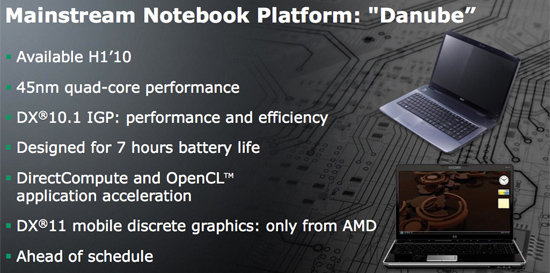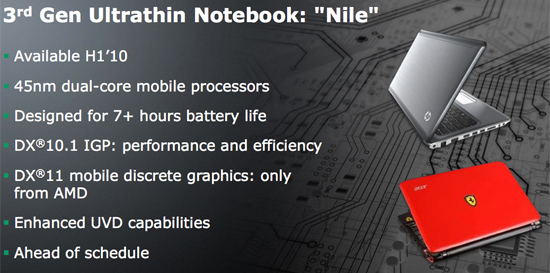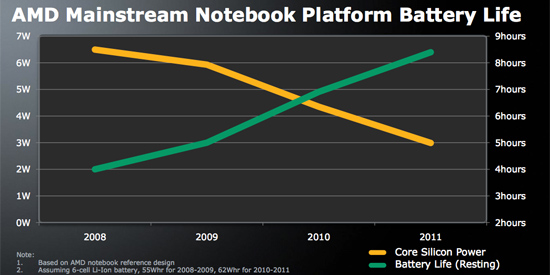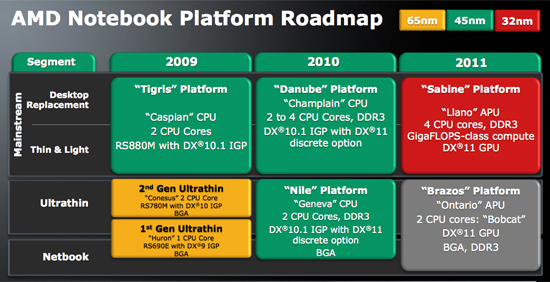AMD's 2010 - 2011 Roadmaps: ~1B Transistor Llano APU, Bobcat and Bulldozer
by Anand Lal Shimpi on November 11, 2009 12:50 PM EST- Posted in
- CPUs
The Notebook Roadmap
For mainstream notebooks today AMD doesn’t really offer anything sexy. We have the Tigris platform based on the Caspian CPU (45nm Athlon II X2 derivative) and RS880M chipset with integrated Radeon HD 4300 series graphics (DX10.1).

Next year we get the Danube platform, complete with Champlain CPU (Athlon II X2 or X4 derivative) and relatively similar graphics to what we have now.
Like the desktop roadmap, things don’t get interesting until 2011; that’s when we meet Sabine.
Sabine comes with a Llano APU, just like the desktop, and four 32nm Phenom II-like cores. There isn’t a dual-core mainstream offering for mobile on the roadmap. Llano of course comes with a DX11 GPU on die, which AMD is calling GigaFLOPS-class. I guess we won’t have 4870 level performance on die at 32nm.
AMD doesn’t have a high performance CPU for ultrathin notebooks today. The only options are Consesus and Huron, both first generation K8 derivatives. They’re also fabbed at 65nm so they’re not exactly as small or power efficient as they could be.

Next year this starts to change with the Nile platform. It comes with a Geneva CPU, a lower power Athlon II derivative. That should help fix the performance issues. At 45nm we’ll hopefully see good battery life from the platform.

Come 2011, AMD has another CPU core for us; it’s called Bobcat. I first talked about Bobcat over two years ago, and we won’t see it for nearly another two years, incredible. It’s an ultra low power microprocessor architecture specifically designed for mobile. Assuming AMD didn’t exaggerate its claims, this should be the first real mobile competitor Intel has seen.

Bobcat will appear in the Ontario APU as a part of the Brazos platform. Hooray for more codenames.

If you look at AMD’s roadmap there are a couple of subtle hints to pay attention to. Note that Brazos extends top to bottom from Ultrathin down to Netbook, whereas no other AMD platform has ever completely gone down to the bottom of the Netbook segment. Could this be an indication of AMD’s ability to hit ultra low, Atom-like, pricepoints with Bobcat?
Secondly - the Brazos platform isn’t colored yellow, green or red for 65nm, 45nm or 32nm. I'm guessing that means Ontario will be built on a bulk 28nm process to save cost.
When I spoke to Globalfoundries earlier this year they indicated that fabbing on half nodes could be one option exploited by CPU companies looking to compete with Intel.










59 Comments
View All Comments
themusgrat - Wednesday, November 11, 2009 - link
That's got to be an honest mistake. Fix it please. If it's not, my time here is done, was a good run Anand, you once were a valued voice in the PC community.T2k - Wednesday, November 11, 2009 - link
there's no mistake here - it's nothin g but a typical giant DOUCHE article from a your giant DOUCHE, Anand Lai Shimpi.Most his pieces are either boring or full of rehashed stuff - I often wish he would stick to counting the beans and just leave the fuck this site alone, to people who know how to write etc.
This piece perfectly illustrates how much he has to do with writing or journalism or news - nothing.
DaveninCali - Wednesday, November 11, 2009 - link
Come on, Anand. This is really poor form. A roadmap article about AMD only and you include this Intel slide as the first image. I have to agree with everyone else, you made a BIG mistake here.Griswold - Wednesday, November 11, 2009 - link
I have to agree with that. It doesnt matter if you want to get the point across that Intel is doing this and that a year ahead yadda-yadda.If it is supposed to be an article about AMDs roadmap, the first slide/picture/whatever should certainly not include an Intel logo... park that and the conclusion at the end of it.
srp49ers - Wednesday, November 11, 2009 - link
What has happened to this site. It has happens slowly yet surely.Intel ad right the top of an "AMD" article. Poor taste and highly suspect.
Hope the money is good....
Carleh - Thursday, November 12, 2009 - link
Intel is not playing catch-up with AMD, so it has no reason to waste money marketing its products this way. Besides, the offending slide was removed.JimmiG - Wednesday, November 11, 2009 - link
Seriously AMD's road map for 2010 is about as boring as it gets. Some users will appreciate the 6-core CPUs. However, per-core performance will probably be lower than current Quads because of lower clock speeds and lower cache to core ratios. AMD will be forced to compete in the $150 segment and below for all of next year - and do so using chips that are as big and complex as the $999 i7's...AMD really needs a new micro-architecture. Very high clock speeds, larger caches etc. have made the K10 architecture reasonably competitive with Core 2. However this isn't 2006, this is the end of 2009...
GeorgeH - Wednesday, November 11, 2009 - link
AMD's mobile roadmap (even if they stick to it) is very disappointing; it looks like Intel will barely even have to try to stay on top. Sure AMD's IGPs will be better, but real performance will still come from discrete GPUs. All Intel has to do is make a "good enough" IGP with very low power consumption, enable seamlessly switchable discrete graphics, and boom - AMD's mobile offerings are relegated to the extreme low end for another few years.As laptops continue to supplant desktops, it looks like AMD will be surrendering even more of the consumer market and mindshare to Intel in the coming years.
fitten - Wednesday, November 11, 2009 - link
I want to hear more about this: "A major focus is going to be improving on one of AMD’s biggest weaknesses today: heavily threaded performance. Intel addresses it with Hyper Threading, AMD is throwing a bit more hardware at the problem. The dual integer clusters you may have heard of are the route AMD is taking..."JACKDRUID - Wednesday, November 11, 2009 - link
AMD is lucky Intel totally flops on IGPs... else they'd be out of business by now due to their inability to compete.On the other hand, 785/790 chipsets really turned AMD around. Excellent IGP for people who don't do too much gaming (however would like to be able to play some occasional light gaming or favorite older games).
for my next upgrade, I would still go with AMD or NV?? if Intel continues to flop on IGPs. However, if they somehow get a comparable igp, i would switch in no time.